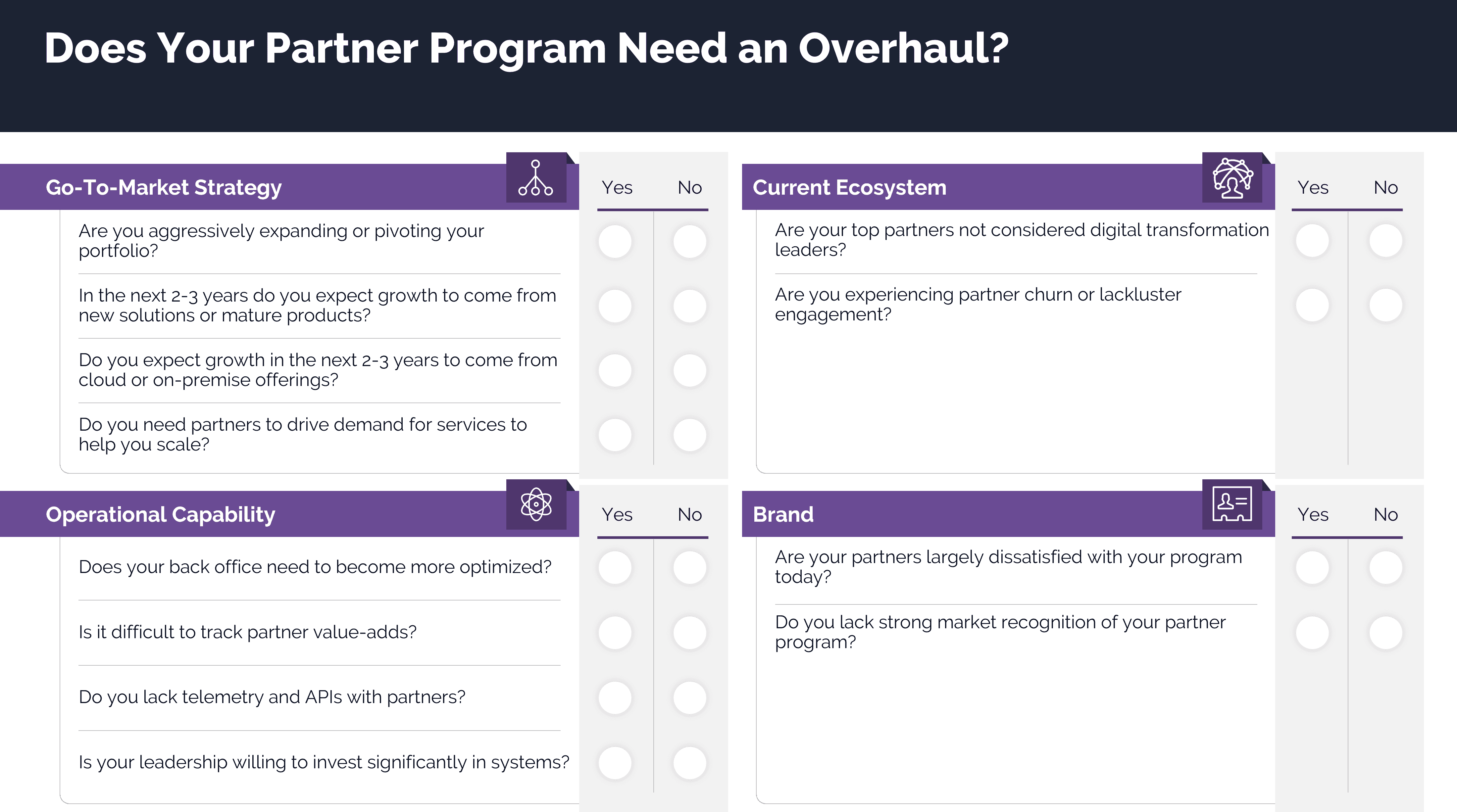Does your partner program have just one track? Do you have multiple partner programs? Are your tiers named after precious metals? Do you keep trying to garner more partner engagement by tweaking the volume requirements and margins by tier, hoping that if you have the magic combination, you'll double your ROI?
If you answered 'yes' to any of the above questions, you might need a program refresh or overhaul.
Is your partner program outdated?
As the technology industry has matured, power has shifted from vendors to customers and those who own relationships with customers. The owners are typically partners who have worked hard to establish themselves as trustworthy digital transformation partners to their clients. As a result, vendors need to prepare to compete for mindshare with top partners. Partner programs allow you to engage with your partner ecosystem at scale; therefore, your investment into your programs can potentially yield significant results in partner engagement, capability growth, increased capacity, and customer value add.
As you consider overhauling your partner program, consider program elements from vendors with the best partner experiences. Next-generation programs often include the following:
- An optimized experience
- A clear path by value motion
- A rich resource portfolio
- An intuitive digital interface
- A transformative roadmap
Design principle #1: An optimized experience
"Programmatic sprawl" is a common byproduct of quick growth, but it will likely introduce roadblocks to your partners. Most partners work with multiple vendors, so vendors can turn simplicity and automation into competitive advantages when partners are deciding whether to build or deepen a partnership.
Potential roadblocks for partners include: multiple partner programs and contracts, no clear next steps post-enrollment, intensive or complicated programmatic requirements, requiring manual proof of advertising or other activities, opaque incentives schemes, lack of partner-facing dashboards, and slow partner portals.
If your offering is as good as your competitor's, yet you make it twice as hard to collaborate, don't be surprised if your ecosystem shows signs of atrophy.
Design principle #2: A clear path by value motion
It's not just vendors who are undergoing the transformation to cloud and SaaS; partners are evolving as well. Partners build, service, and sell — and the selling motion is likely a declining share of profit for your partners.
Next-generation partner programs are built for partners who drive value for customers across the entire customer lifecycle. They're designed for partners to profit from developing and driving win-win services offerings, which could mean reducing unused software and customer churn, accelerating market share and revenue growth, and reducing time to value realization with your company.
However, if you're like many of our clients, you still value your transactional partners' contributions to your revenue. To ensure your partner program fits the partners you have or want in your ecosystem, you should design clear paths for distinct value motions and/or partner types.
Design principle #3: A rich resource portfolio
If your program's benefits stop at incentives and training credits, you're likely not competitive enough. Today's partners seek to engage with and invest in vendors who help them build a profitable practice and develop differentiated IP. Allow program enrollment and advancement to unlock resources that matter to partners. Ideas include:
- Activation kits
- Sandbox access
- Not for resale (NFR) or SaaS trial access
- Increased access to your field and other partners in the ecosystem
- Co-marketing assets
- Business intelligence (BI) and APIs to facilitate partner-driven customer success
- Advanced reporting and analytics for telemetry
- Executive sessions
- On-demand training enablement
Design Principle #4: An intuitive digital interface
Your partner portal has the potential to be a key driver of partner scale and satisfaction. As partners work with multiple vendors, accessing the resources they need to succeed should be effortless.
However, many partners complain about vendors' sprawling and unintuitive portals. These factors make it next to impossible to find benefits, requirements, additional resources, enablement, incentives and program details, partner/distributor locators, or relevant reporting.
Make the online experience for partners a competitive advantage by regularly testing core user paths (e.g. onboarding, finding details on rebates, identifying quarterly accelerators, registering for a product launch webinar) and implementing AI to optimize search and recommend resources to partners based on their engagement level.
Design Principle #5: A transformative roadmap
Partners want to grow with vendors who possess the right business fit and market momentum. Clarify upfront to potential partners why you're the right choice for a working relationship. We recommend introducing your program with the partner value proposition, showing how potential partners will turn a profit by growing their business with you.
Beyond demonstrating how your solutions meet customer needs, let top partners know how they can be recognized for their expertise in your ecosystem. For partners who are trying to adapt to a cloud-first world, show that you possess the resources they need to transform their business. Then, ensure your partners have what they need for each step of their journey.
Refresh vs. overhaul
Finally, it's worth considering: does your program need an overhaul? Let's evaluate:

- Go-to-market (GTM) strategy: Are you aggressively expanding or pivoting your portfolio? In the next 2-3 years do you expect growth to come from new solutions or mature products? What about cloud or on-premises offerings? Do you need partners to drive demand for services to help you scale?
- Current ecosystem: Are your top partners not considered digital transformation leaders? Are you experiencing partner churn or lackluster engagement?
- Operational capability: Does your back office need to become more optimized? Is it difficult to track partner value adds? Do you lack telemetry and APIs with partners? Is your leadership willing to invest significantly in systems?
- Brand: Are your partners largely dissatisfied with your program today? Do you lack strong market recognition of your partner program?
Turning your partner program into a competitive advantage
Ready to increase your partner engagement, grow partner capacity and capability, and unlock the full value of your partner ecosystem? Consider refreshing or overhauling your partner program or your key ecosystem scale engine to meet the needs of today's partners.
When well-aligned to your specific GTM strategy and solution portfolio, a next-generation program can accelerate key customer outcomes — and benefit you and your partners' bottom lines.

